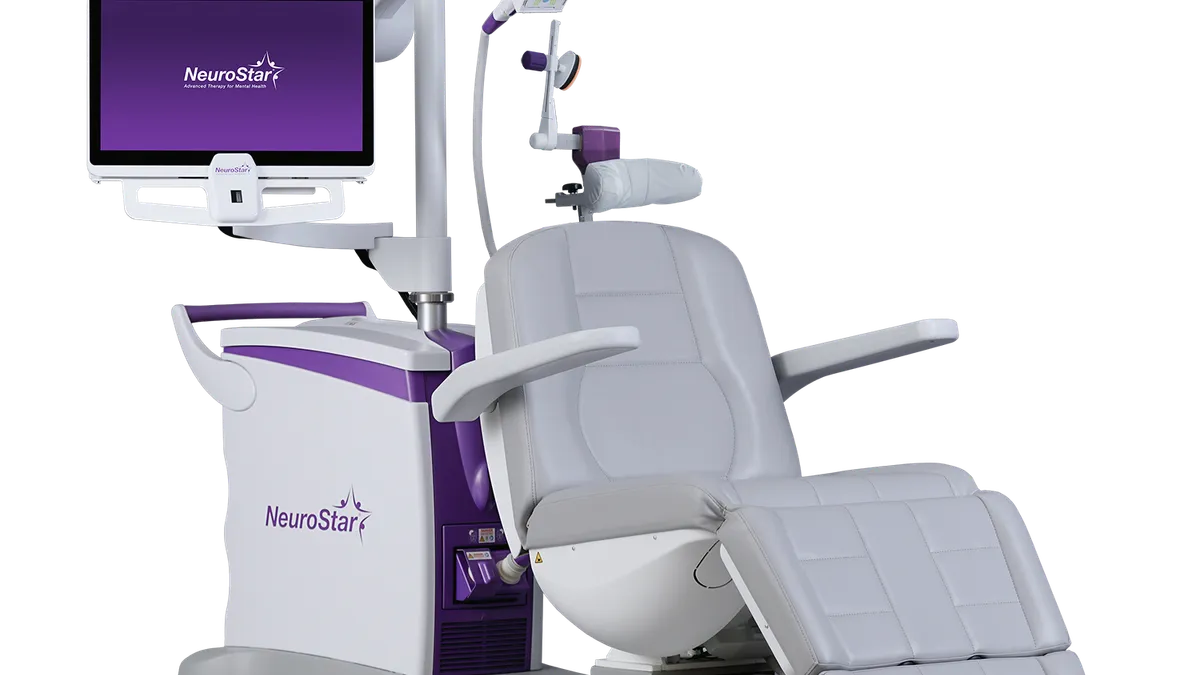Dive Brief:
- Neuronetics said Monday it has agreed to merge with Greenbrook TMS to acquire treatment centers that use its mental health devices.
- Greenbrook provides transcranial magnetic stimulation (TMS) and other mood treatments from 130 sites. Neuronetics sells a TMS device to treat major depressive disorder (MDD).
- William Blair analysts said in a note to investors that the merger changes Neuronetics’ profile “from device-centric to a device-service business operating brick-and-mortar facilities.”
Dive Insight:
TMS therapy delivers electromagnetic stimulation to regions of the brain associated with mood regulation. The treatment is considered non-invasive because it is done without surgery, and it’s typically used when other treatments for major depressive disorder haven’t been effective, according to the Mayo Clinic.
Neuronetics CEO Keith Sullivan made the case for the merger on a Monday earnings call, telling investors he expects optimization of marketing spending and back-office functions to generate annual cost savings of at least $15 million. Sullivan expects to realize most of the savings in 2025.
Neuronetics’ stock fell 58% to close at 75 cents on Monday after the company disclosed the merger and its second-quarter results.
William Blair analysts said the success of this merger will depend on Neuronetics’ ability to realize synergies. Neuronetics aims to close the deal in the fourth quarter, and the analysts said it will take the company several quarters to “make its mark” on the acquisition.
“This will be a process that needs to be proven out over time given the new layer of commercial and operational strategy,” the analysts wrote in a note to investors.
Sullivan said Neuronetics expects 15% growth between the two companies in 2025. The forecast reflects the opening of additional opportunities for Spravato, the Johnson & Johnson drug that Greenbrook offers at its centers, and “marketing synergies” that Sullivan expects to realize after the merger.
“We will be able to amplify brand awareness and, with this unified approach, boost brand recognition, with the goal of making Neurostar the household name for TMS therapy,” Sullivan said. “What this means is that all the Neurostar systems inside our customers' practices will become even more recognizable to their patients, making it easier to treat patients in need.”
The potential to increase Neurostar’s brand recognition underpins Sullivan’s claim the deal will benefit Neuronetics’ other customers. Greenbrook is Neuronetics’ largest service customer and accounts for an estimated 5% to 10% of total sales, according to William Blair analysts. As such, merging with Greenbrook puts the device company in competition with other customers, but Sullivan contends that everyone will benefit through increased recognition.
Neuronetics disclosed the merger alongside results for the second quarter. Revenue fell 7% year over year to $16.5 million, in part because of a 5% decline in U.S. treatment session revenue.
Management attributed the revenue figure, which fell short of its guidance, to the effect of the Change Health cyberattack on purchasing patterns. Customers deferred purchase because of cash flow issues, the company said.












